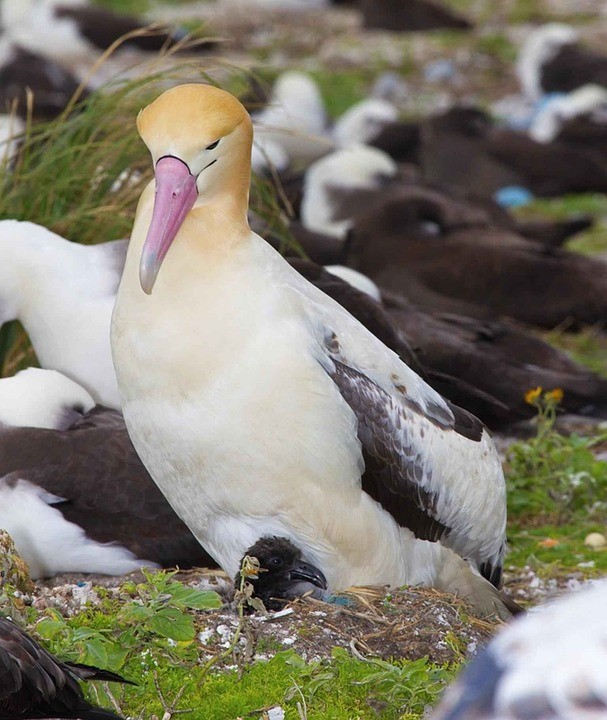Short-tailed Albatross
A species of North Pacific Albatrosses Scientific name : Phoebastria albatrus Genus : North Pacific Albatrosses
Short-tailed Albatross, A species of North Pacific Albatrosses
Botanical name: Phoebastria albatrus
Genus: North Pacific Albatrosses
Content
Description General Info
Description
The short-tailed albatross is a medium-sized albatross, with a wingspan of 215 to 230 cm (85–91 in), a length of 84 to 94 cm (33–37 in) and a body weight that can be 4.3 to 8.5 kg (9.5–18.7 lb). Among standard measurements, the bill is 12.7–15.2 cm (5.0–6.0 in) long, the tail is 14–15.2 cm (5.5–6.0 in) long, the tarsus around 10 cm (3.9 in) and the wing chord 51 cm (20 in). Its plumage as an adult is overall white with black flight feathers, some coverts, as well as a black terminal bar on its tail. It has a yellow-stained nape and crown. Its bill is large and pink; however, older birds will gain a blue tip. The juveniles are an all-over brown colour, and they will whiten as they mature, in about 10 to 20 years. It can be distinguished from the other two species of albatross in its range, the Laysan albatross and the black-footed albatross by its larger size and its pink bill (with a bluish tip), as well as details of its plumage. Contrary to its name its tail is no shorter than that of the Laysan or black-footed, and is actually longer than that of the other member of the genus Phoebastria, the waved albatross. 
Size
81 - 183 cm
Life Expectancy
12-45 years
Nest Placement
Ground
Feeding Habits
Short-tailed Albatross predominantly forages for squid, supplemented with fish and crustaceans. Displays surface-seizing and pursuit-dive feeding techniques. Adapts uniquely by utilizing regional food abundance, often following fishing vessels for by-catch.
Habitat
Short-tailed Albatross primarily inhabits marine and pelagic environments, frequenting regions with nutrient-rich upwelling currents that support abundant marine life. During the breeding season, short-tailed Albatross nests on islands with somewhat steep volcanic ash slopes, which offer thinly vegetated terrain with plants like Miscanthus sinensis and Chrysanthemum pacificum. Their breeding colonies are located on cliffs, sometimes near vertical and approximately 150 meters high, ensuring a level of protection from terrestrial predators.
Dite type
Piscivorous
General Info
Feeding Habits
Bird food type
Species Status
The IUCN classifies this species as vulnerable, with an occurrence range of 34,800,000 km (13,400,000 sq mi) and a breeding range of 9 km (3.5 sq mi). The short-tailed albatross came perilously close to extinction. They were hunted on an almost industrial scale for their feathers in the later half of the 19th century, with some estimates claiming upward of 10 million birds hunted. By the 1930s the only population left was on Torishima, between 1927 and until 1933 hunting continued when the Japanese government declared the ban of hunting to save the species, after which the albatrosses stopped breeding on the island. At this point the species was assumed to be extinct and research became impossible with the outbreak of World War II. On 1949 an American researcher arriving on this island declared the species to be extinct, but an estimated 50 individuals, most likely juveniles, survived at sea (all albatross species take a long time to reach sexual maturity and will not return to their natal colony for many years). After the return of the birds they were more carefully protected, and the first egg was laid by the returning birds in 1954. Varieties of albatross decoys were placed around on the island after it was discovered that like other albatross species, this species also were enticed to breed if placed in a group. Today, longline fisheries, and volcanic eruptions on Tori-shima are the largest threats; however, introduced predators, environmental contaminants, soil instability, and extreme weather are also threats. There are many measures underway to protect this species. Japan, Canada, and the United States list this bird as a protected species. Tori-shima is a National Wildlife Protection Area, and native plant species are being transplanted to assist in nesting. Also, most commercial longline fisheries use bycatch mitigation devices. 
Scientific Classification
Phylum
Chordates Class
Birds Order
Albatrosses and Petrels Family
Albatrosses Species
Short-tailed Albatross 